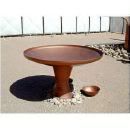
The Laver - ( Exod. 30 :17 21; 38:8 )
The altar was typical of our justification through the atonement of Christ.
The altar was typical of our justification through the atonement of Christ.
God has given us less specific information concerning the laver than of the other articles of furniture in the tabernacle. We are told that it was made of brass (copper), of the brazen mirrors of the women. Here the priests must wash both hands and feet before entering the tabernacle, or ministering at the altar, lest they die. Its shape and size are not given; but probably it was round in shape as was customary of such vessels. It was large enough to contain sufficient water for the washing of the priests, and probably also for the washing of the sacrifices to be burned upon the altar. The laver was located in the court between the brazen altar and the entrance to the tabernacle. It is stated of it, “And he made the laver of brass, and the foot of it of brass.” This seems to imply that the foot was something separate from the laver. Some have supposed the foot was a saucerlike basin below the laver in which the feet and hands of the priests were washed and which supported the laver by a shaft rising from its center.
Typical Leaning.—That the laver had symbolic and typical significance is to be gathered from the importance attached to the washings there. Twice it is stated of the priests who washed there, “That they die not.” Moreover the New Testament is quite clear as to its typical meaning. “He saved us, by the washing of regeneration.” (Tit. 3:5). The marginal reading of the Revised gives “laver” of regeneration instead of “washing.” So it is translated in the Emphatic Diaglott. The same Greek word is used here as is used in the Greek Septuagint in Exod. 30:18 for laver.
This washing at the laver is not to be understood as typifying water baptism, as some have supposed. Sound principles of symbolic interpretation forbid making a literal thing symbolic of a similar literal thing. Besides, this was essential to entrance into the ancient house of God; but one may enter God’s church before water baptism, as was evidently true of the thief on the cross, of Paul, or of Cornelius.
But the “washing of regeneration” is a cleansing that is necessary to entrance into God’s church. Jesus said, “Except a man be born of water and of the Spirit, he can not enter into the kingdom of God” (John 3:5). The kingdom and the church are practically identical. Regeneration and the new birth mean the same. As those justified at the altar and entering that ancient house needed this washing at the laver, so we today need, not only Justification from committed sins, but also regeneration of our hearts.
The laver was typical of this regeneration as the altar was of justification. The water typifies the word of God, which, in conjunction with the Spirit of God, is an agent for effecting the new birth (John 3:5). “Now ye are clean through the word which I have spoken unto you.” (John 15:3). “Of his own will begat he us with the word of [36] truth.” (Jas. 1:18). “Being born again . . . by the word of God.” (I Peter 1:23).
Conversion is twofold in its nature. It brings the sinner into right relations with God, and effects right character in the sinner. thus enabling him to keep in right relation with God. We need to be justified or pardoned of our committed sins, and we need also to have power over the power of the indwelling sinful nature so that we can keep justified by living a holy life. Justification would be of little practical value to us without regeneration. This regeneration is variously described as a new birth, becoming a “new creature,” receiving a “new heart,” and as being “created” anew.
It may be well described as salvation from the reigning power of the sinful nature. We naturally have a depraved nature that impels to sin. This depraved nature is a derangement of the moral nature. It is a perversion of the affections, and a weakening of the conscience and of the will insomuch that the sinner says, “To will is present with me; but how to perform that which is good I find not.” (Rom. 7:18). Now, regeneration is not an entire removal of depravity; for it is the testimony both of the Bible and experience that depravity still remains in some sense in the regenerated. But we know that when one is born again a new power comes into his life that makes him triumphant over the depravity of his nature. Then he can say, “The law [power] of the Spirit of life in Christ Jesus hath made me free from the law [power] of sin and death.” (Rom. 8:2).
The incoming of the Spirit of the Almighty gives power over every sinful desire. “If any man be in Christ, he is a new creature: old things are passed away; behold, all things are become new.” (2 Cor. 5:17). “We know that whosoever is born of God sinneth not.” (I John 5:18). “A new heart also will I give you …. And I will … cause you to walk in my statutes, and you shall keep my judgments, and do them.” (Ezek. 36:26, 27).
Thank God, we are not only pardoned at the altar, Christ, but we are enabled to live well pleasing to God by [37] the laver of regeneration. How beautifully the process of our salvation is foreshadowed in this ancient type! It is a clearer and more systematic presentation of the method of salvation than is given anywhere in the New Testament.
*****
continued, next the sanctuary
No comments:
Post a Comment